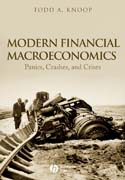
"Modern Financial Macroeconomics" takes a non-technical approach in examiningthe role that financial markets and institutions play in shaping outcomes in the modern macro economy. It reviews historical and contemporary macroeconomictheory. It examines governmental influence on moderating (or exacerbating) economic fluctuations. It discusses both empirical and theoretical links betweenfinancial systems and economic performance, as well as case studies detailingthe role of finance in specific business cycle episodes. INDICE: List of Figures.List of Tables.List of Case Studies.Preface.Introduction.Part I: An Introduction to Finance and Macroeconomics:.1. The Basics ofFinancial Markets and Financial Institutions.2. A Brief History of Financial Development.Part II: Macroeconomic Theory and the Role of Finance:.3. BusinessCycles and Early Macroeconomic Theories of Finance.4. Keynesian, Monetarist, and Neoclassical Theories.5. New Institutional Theories of Finance: Models of Risk and the Costs of Credit Intermediation.6. New Institutional Theories of Finance: Models of Credit Rationing.Part III: Financial Volatility and Economic[In]Stability:.7. The Role of Financial Systems in Monetary and StabilizationPolicy.8. Banking Crises and Asset Bubbles.Part IV: International Finance andFinancial Crises:.9. Capital Flight and the Causes of International FinancialCrises.10. International Financial Crises: Policies and Prevention.Part V: Conclusions:.11. What We have Learned, What We Still Need to Learn about Financial Macroeconomics.Bibliography.Index
- ISBN: 978-1-4051-6180-0
- Editorial: Blackwell
- Encuadernacion: Rústica
- Páginas: 288
- Fecha Publicación: 01/03/2008
- Nº Volúmenes: 1
- Idioma: Inglés
